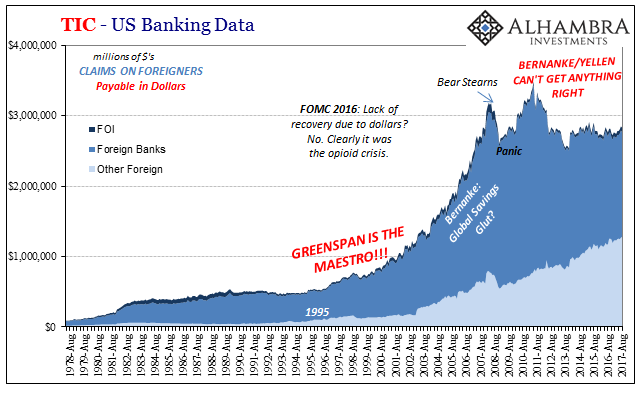The Chinese government has sold its first dollar bond issue in thirteen years. Given that fact alone, the idea is causing more than a little confusion, perhaps consternation. Why now? What are they really up to? It seems as if it is contradictory, especially given China’s very public positions against the dollar as hegemonic reserve (the coming market for oil in CNY, for one).
There is no inconsistency here, though; there is instead the dollar rock meeting the economic hard place. The Chinese still need dollars, billions of them, hundreds of billions, in fact. They can’t just tomorrow decide to pay for everything that goes into China in RMB as the economy would immediately collapse. Dollar defaults would send shockwaves throughout the global system in a way that would make 2008 look pitifully small, and it would hit China the hardest.
The dollar short applies to China more than any other country on Earth. To pay for everything that has already made its way to that country, Chinese banks have had to borrow those dollars primarily from eurodollar banks trading on eurodollar markets. The liquidity provided by those eurodollar markets are the problem; it has made procuring dollars the Chinese need more difficult, expensive, and occasionally prone to drastic interruption (August 2015 & January 2016 more recently).
What do you do if you find yourself in that situation? You still need dollars, but it isn’t so easy anymore.
You do a couple of things, one of which is to work feverishly toward reducing any marginal need to transact in dollars. CNY for oil is one way, including getting repaid prior dollar loans from all across Africa in direct crude shipments, as are the small bilateral trade agreements signed between China and a number of other countries. Those, however, only marginally reduce China’s bogey, they do not get close to eliminating it.
Another alternative is the bond market; in the very same way using the very same vehicle US and European companies turned to in early 2009. If you couldn’t get liquidity financed via bank-drawn dollars, you could at least build up a liquidity cushion, in dollars, via the floatation of longer-term paper.
This, however, comes at a cost. Bank-derived dollars are almost always the shortest-term, meaning largely overnight, if occasionally termed out a week or maybe a month. There is a huge interest rate differential between obtaining bank-funded eurodollars and longer-term Eurobonds. So while you can get dollars via this workaround, you have to pay up for the privilege.
The Chinese government in issuing its dollar bond in the coming weeks is trying to reduce the cost that Chinese corporates (largely financials) might have to pay if they increasingly go this route. Bond markets, like other markets, work on benchmarks. The cheaper the government can get on its coupons, the cheaper it will be for China’s corporate sector that follows along after it (in theory).
The implications here are already visible via Hong Kong. Chinese officials have been trying, often desperately, to reopen the pipeline of bank-drawn eurodollars with little or no success. The last scheme involved some kind of guarantee, currency cover, or even directive for Chinese banks to borrow through or from Hong Kong, in US dollars, using HKD as both a funding vehicle and a cover.
We don’t know exactly when the bond sale was pitched to Wall Street, but it’s reasonable to assume it came together rather quickly following the week of September 5.




This bond business is really another indication of the continuing negative progression for China’s “dollar” problem; specifically that this (in some ways impressive, at least imaginative) Hong Kong plot might not have worked out well enough to buy more time. If that was the case, you would expect Chinese officials to have a Plan B lined up (or Plan Z, as it might be more realistically classified).
Ultimately China’s real problem is Janet Yellen. Not that her RHINO’s are causing eurodollar problems, but that the US central bank pays no attention at all to eurodollars and sees them as nothing more than a funny, quirky little niche part of the global market rather than the world’s actual, effective reserve currency. Thus, the Chinese in seeking a way out of the eurodollar’s constant pains have no one to realistically negotiate with where it would really matter. Every Treasury, Finance Ministry, or central bank official in the West would be discussing global currency with them as if it was still 1955.
The Chinese still need a whole lot of dollars and inventive ways to find and obtain them, and at the same time they are actively trying to reduce how many dollars they still need. There is no contradiction, just more confirmation of what continues to be the world’s biggest problem. How does one lost decade become two, or even three? We are finding out in real time.



Source: http://www.alhambrapartners.com/2017/10/26/global-asset-allocation-update-26/


